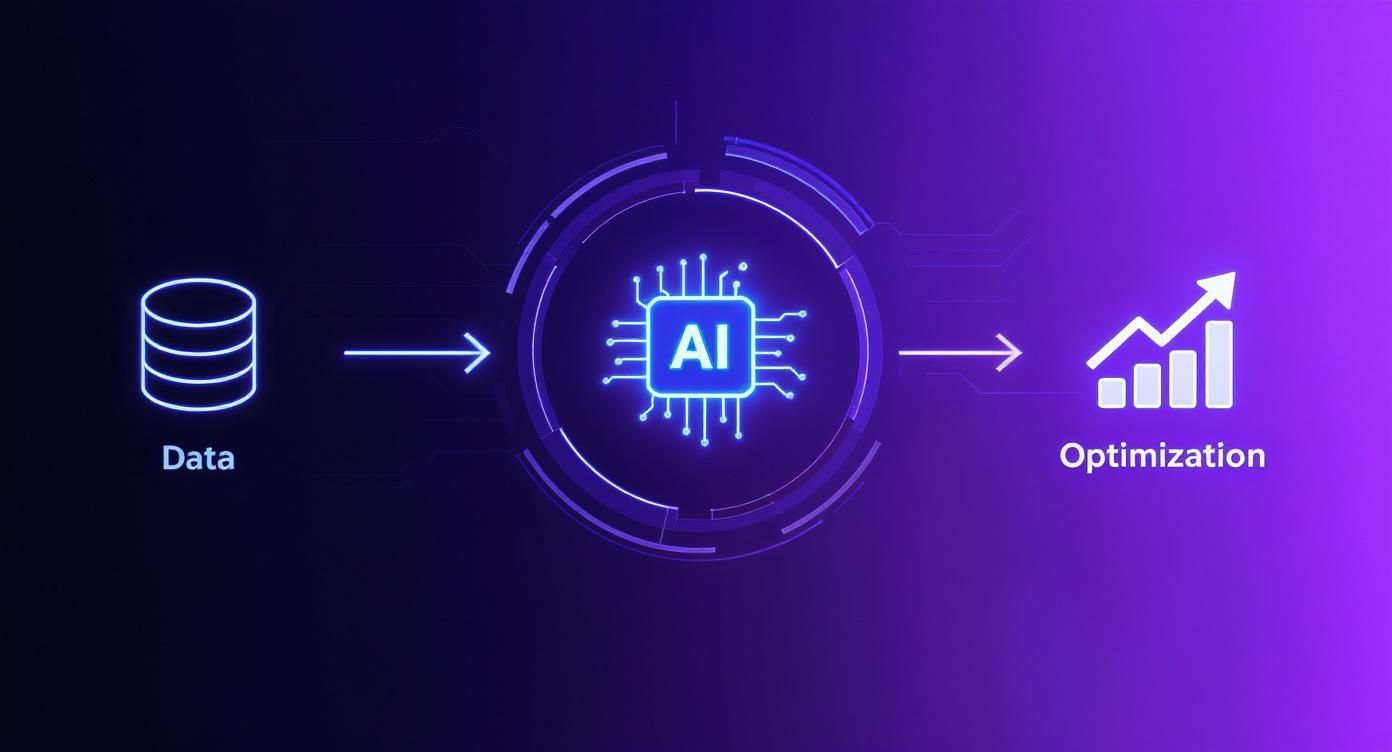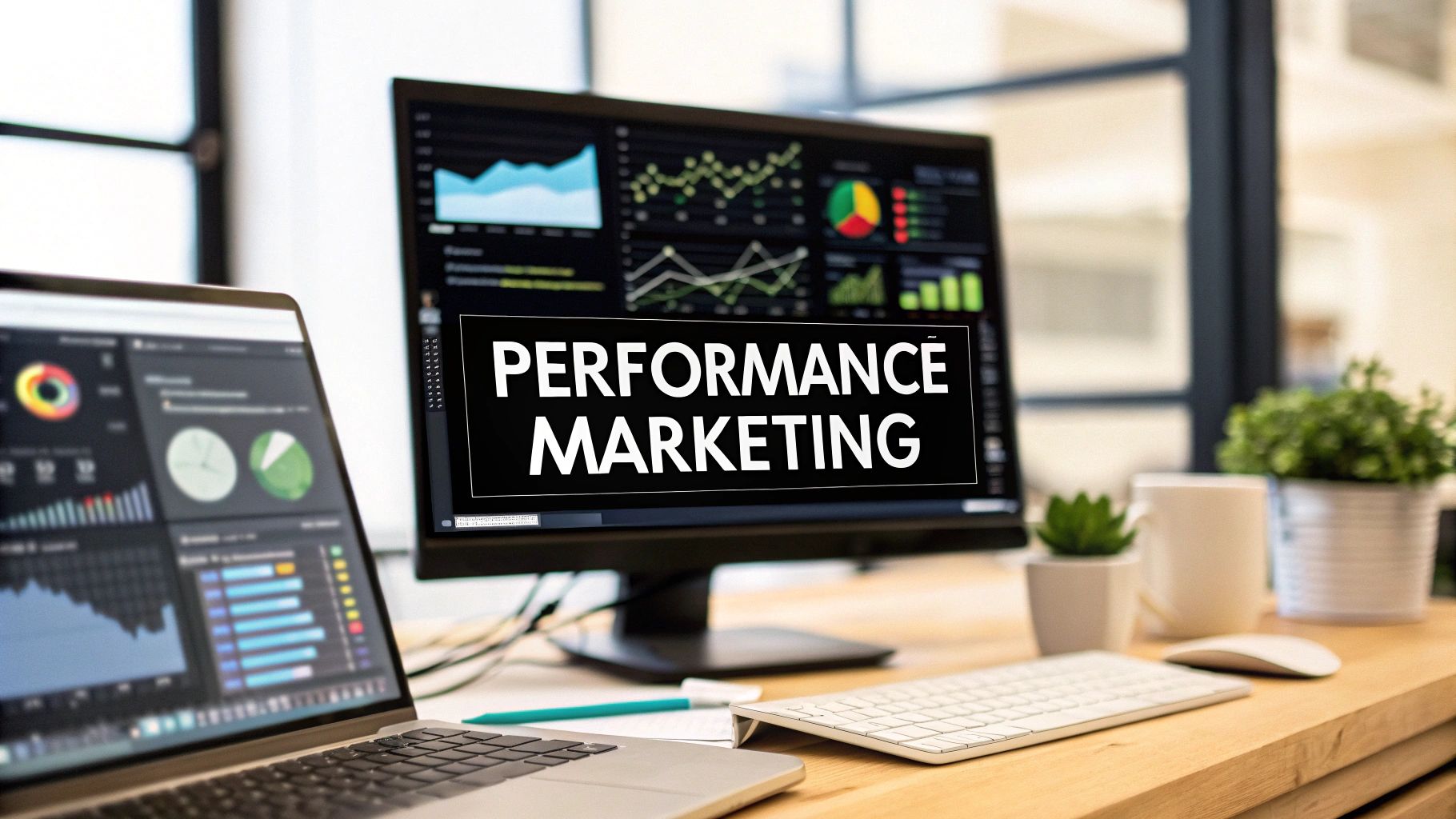Imagine traditional advertising as paying for a billboard on a busy highway. You pay a flat fee hoping the right people see it and decide to visit your store. It's a game of educated guesses.
Now, what if you only paid for the billboard when someone who saw it actually walked into your store and made a purchase? That’s the essence of performance marketing. It's an advertising model built on results, where you only pay when a specific, measurable action happens—like a sale, a new lead, or even just a click.
Unpacking The Pay-For-Results Model

At its heart, performance marketing flips the traditional risk model on its head. Instead of the advertiser shouldering all the risk by paying for ad space upfront, that risk shifts to the publisher or marketing partner. You aren't just buying eyeballs or potential reach; you're buying concrete outcomes.
This built-in accountability makes it a potent growth driver for businesses of every size, from scrappy startups to established enterprises. For a great primer on this, check out this guide on What Is Performance Marketing.
The entire system is based on a transparent handshake between two core players:
- Advertisers (or Brands): These are the businesses with a product or service to sell. They set the terms, defining exactly what action they’ll pay for.
- Publishers (or Partners): These are the marketing pros who promote the offer. They could be bloggers, social media influencers, or savvy media buyers who know how to generate traffic and drive conversions.
The Key Players In The Ecosystem
Often, a third party—a performance marketing network or platform—acts as the bridge between advertisers and publishers. Think of them as the orchestrator. They provide the tracking technology, reporting dashboards, and payment systems that make the whole thing work, connecting thousands of brands with countless partners in a seamless marketplace.
The advertiser gets exactly what they paid for with minimal upfront risk. The publisher earns a commission for their marketing skill. And the customer finds a product they love. It's a win-win-win scenario fueled by shared success.
The sheer growth of this model tells the story. In the United States alone, affiliate marketing (a cornerstone of performance marketing) exploded by 49.8%, climbing from $9.1 billion in 2021 to a projected $13.62 billion in 2024. That growth rate is more than double the pace of the wider e-commerce market, showing just how essential this strategy has become.
This direct line between advertising spend and tangible results is why so many businesses are shifting their budgets. Many of these core principles also apply to a related and equally powerful strategy; you can learn more in our guide on what is partner marketing.
So, how does this stack up against the old-school methods? Let's break it down.
Performance Marketing vs Traditional Marketing At a Glance
The table below gives you a quick snapshot of the fundamental differences between these two approaches.
| Attribute | Performance Marketing | Traditional Marketing |
|---|---|---|
| Payment Model | Pay-for-performance (CPA, CPL, CPC) | Pay-for-placement (upfront cost for ad space) |
| Measurement | Highly trackable and data-driven | Difficult to measure direct ROI |
| Risk | Lower risk for the advertiser | Higher risk for the advertiser |
| Focus | Direct ROI and specific conversions | Brand awareness and broad reach |
While traditional marketing still has its place for building brand awareness, performance marketing is all about driving measurable growth with a clear return on every dollar spent. It's less about hope and more about data.
A Look at the Core Performance Marketing Channels

Performance marketing isn’t just one single tactic; it’s a strategy that comes to life across a handful of key channels. I like to think of it as a well-stocked toolbox. Each tool has a specific job, but they all work together to build something solid. Getting to know these core channels is your first real step toward putting together a campaign that actually delivers.
Each one gives you a different way to reach potential customers, whether you're trying to grab their attention right now or build a relationship for the long haul. The real trick is figuring out where your audience actually spends their time and picking the right channel mix to meet them there.
The entire digital ad industry—which really runs on these channels—is on track to hit $1.16 trillion globally by 2030. That's no accident. This growth is being fueled by the sheer effectiveness of performance pillars like search and social. To give you an idea, a full 50% of consumers found new products on social media platforms in 2023 alone. You can dig into more numbers like these by checking out these digital marketing statistics.
Paid Search: Capturing Red-Hot Intent
Think of paid search, or Pay-Per-Click (PPC), as setting up a pop-up shop right at the finish line of a marathon. You’re meeting customers the very second they're actively looking for a solution you offer. Your ads show up at the top of search results on platforms like Google Ads or Microsoft Advertising, zeroing in on keywords that scream "I'm ready to buy."
Someone typing "buy waterproof running shoes" into Google is worlds away from someone casually scrolling through their social feed. That’s what makes PPC so potent for driving sales and leads right away. And the model couldn't be simpler: you only pay when someone actually clicks on your ad.
Affiliate Marketing: Building an Army of Advocates
Affiliate marketing essentially turns your biggest fans into a commission-based sales team. With this model, you partner up with others—we call them affiliates or publishers—who promote your products to their own audiences. They could be bloggers, YouTubers, or social media influencers who earn a cut for every sale or lead they send your way.
The beauty of this channel is that it's incredibly low-risk. You're only paying for actual, measurable results. It’s a brilliant way to tap into new communities and borrow the trust that your affiliates have worked so hard to build with their followers.
You could say affiliate marketing is the ultimate win-win. Brands get in front of new, highly relevant audiences with almost no upfront cost, and affiliates get to monetize their influence by sharing products they genuinely stand behind. The whole system is built on shared success.
Paid Social: Creating Demand with Pinpoint Accuracy
Paid social is all about running targeted ad campaigns on platforms like Facebook, Instagram, and LinkedIn. While paid search is fantastic for capturing existing demand, paid social is where you go to create it. These platforms know an incredible amount about their users—their demographics, what they're interested in, and how they behave online.
All that data lets you target your ads with surgical precision. You can get your brand in front of people who perfectly match your ideal customer profile, even if they've never heard of you before. It’s a fantastic channel for everything from just getting your name out there to driving sales directly with eye-catching visuals and interactive ads. You're not just advertising; you're engaging with communities and leading them on a journey.
Measuring Success with Key Performance Metrics
https://www.youtube.com/embed/qQwloQQ5q1I
In performance marketing, there's no room for guesswork. Everything is trackable, and every dollar has a job to do. This data-first approach means you can see exactly what's working and what isn't—but only if you know which numbers to watch.
Think of Key Performance Indicators (KPIs) as the vital signs for your marketing campaigns. They tell the real story behind the clicks and impressions, showing you precisely how your budget is translating into tangible results. This allows you to make sharp, profitable decisions instead of just hoping for the best.
Core Conversion Metrics
At the heart of it all are the metrics that measure customer actions. These are the bread and butter of performance marketing, telling you how efficiently you're turning prospects into customers.
Cost Per Acquisition (CPA): This is the bottom-line number. It tells you exactly how much it costs to get one new paying customer. For instance, if you spend $1,000 on a campaign that brings in 20 new customers, your CPA is $50. It’s the ultimate reality check for your campaign's efficiency.
Cost Per Lead (CPL): Not every business closes a deal on the first click, especially in industries like B2B SaaS. CPL measures how much you're spending to get a qualified lead—like someone signing up for a demo or downloading a whitepaper. It’s a critical early indicator of campaign health.
These metrics give you a clear picture of the immediate costs of your marketing. You can explore this topic further in our complete guide on measuring marketing campaign effectiveness.
Measuring Profitability and Long-Term Value
Knowing your CPA is a great start, but it doesn't reveal profitability or long-term growth potential. For that, you need to look at the bigger picture with more strategic metrics. One of the most fundamental is Return on Ad Spend (ROAS); learning how to calculate return on ad spend is non-negotiable for understanding if your ads are actually making you money.
A low CPA looks great on a dashboard, but if those customers never buy from you again, you might be losing money in the long run. The smartest marketers balance immediate acquisition costs with long-term customer value.
This is where the concept of Lifetime Value becomes so powerful.
Lifetime Value (LTV) is a projection of the total revenue you can expect from a single customer over the entire course of your business relationship.
Let’s put it into context. A customer might have a CPA of $50, but if their LTV is $500, that initial cost is a fantastic investment. This simple shift in perspective is what separates good performance marketers from great ones. It proves that paying more to acquire the right kind of customer—the one who stays loyal and keeps buying—is far more profitable than chasing cheap, one-time sales.
Essential Performance Marketing Metrics Explained
To really get a handle on your campaign's health, you need to be fluent in the language of its key metrics. The table below breaks down the most important KPIs, what they measure, and why they're so critical for making smart decisions.
| Metric (Acronym) | What It Measures | Why It's Important |
|---|---|---|
| Cost Per Click (CPC) | The average amount you pay for a single click on your ad. | Helps you understand the cost of driving traffic and manage your ad spend on platforms like Google Ads and Facebook. |
| Click-Through Rate (CTR) | The percentage of people who see your ad and then click on it. | A high CTR indicates your ad copy and creative are compelling and relevant to your target audience. |
| Cost Per Acquisition (CPA) | The total cost to acquire one paying customer. | This is the ultimate measure of efficiency, telling you if your marketing spend is directly leading to new business. |
| Return on Ad Spend (ROAS) | The amount of revenue generated for every dollar spent on advertising. | It directly answers the question, "Is my ad spend profitable?" A ROAS above 1 means you're making more than you're spending. |
| Lifetime Value (LTV) | The total predicted revenue a single customer will generate over their lifetime. | Shifts focus from short-term gains to long-term profitability, helping you justify higher acquisition costs for valuable customers. |
Understanding these metrics isn't just about crunching numbers; it's about seeing the story they tell. By tracking them closely, you can fine-tune your campaigns, eliminate waste, and build a predictable engine for sustainable growth.
How AI Is Reshaping Performance Marketing
The world of performance marketing is getting a serious upgrade, and the engine behind it is artificial intelligence. AI is quickly turning the manual, often tedious, work of campaign management into a high-powered strategic advantage.
Think of it like swapping out a hand-drawn map for a real-time GPS. The old map got you there, eventually. But the GPS not only shows you the best route—it reroutes you around traffic jams you haven't even hit yet. That’s what AI is doing for marketing.
AI algorithms are now the brains behind many of the core functions we rely on. They’re running the show on real-time bidding for ad placements, predicting which customers are on the verge of buying, and even tweaking ad creative on the fly to see what works best. It’s a massive shift from making reactive adjustments to making predictive, intelligent decisions.
AI gives marketers the ability to comb through massive datasets and spot subtle patterns in customer behavior that a human analyst would never see. This replaces educated guesses with data-backed certainties, unlocking a completely new level of precision.
Driving Efficiency and Precision with AI
Where AI really shines is in its power to automate the complex, time-consuming tasks. Instead of spending hours manually adjusting budgets or tweaking targeting settings, marketers can now set the high-level goals and let AI manage the nitty-gritty details.
This frees up marketers to focus on what humans do best: big-picture strategy, creative thinking, and understanding the customer on a deeper, more empathetic level.
Imagine an e-commerce store launching a flash sale. An AI-powered system can:
- Spot trending products by analyzing sales data and social media buzz in real time.
- Automatically reallocate ad spend to push those trending items, capturing the surge in demand.
- Tailor ad copy and images for different customer groups to get the best possible conversion rates.
This whole cycle happens in minutes, not days. The impact on efficiency and return on investment is huge.
The Future Is Automated
The combination of AI and automation is fundamentally changing how performance marketing gets done. The AI marketing market is on a trajectory to explode, with projections hitting over $107.5 billion by 2028. This isn't just a future trend; it's happening now. A full 88% of marketers are already using AI tools in their day-to-day work, tapping into their power for hyper-personalized targeting and dynamic creative. You can discover more insights about AI marketing statistics to see just how widespread this has become.
This shift means the role of a marketer is evolving. We're no longer just managing campaigns; we're managing the intelligent systems that run the campaigns. AI isn’t replacing skilled professionals—it's arming them with smarter tools to get better results, blending the art of marketing with the precision of data science.
Building Your First Performance marketing Strategy
Alright, let's move from the 'what' to the 'how'. This is where the real fun begins. Launching your first performance campaign can feel like a huge task, but it really just boils down to a clear, step-by-step process. Think of it less like launching a rocket and more like following a recipe—get the ingredients and steps right, and you'll end up with something great.
The absolute bedrock of any good strategy is clarity. Fuzzy goals like "get more sales" are a recipe for wasted money. You need something concrete, something measurable. A solid goal sounds more like: "Achieve a Cost Per Acquisition (CPA) of $50 for new customers within the first quarter." See the difference? That gives you a real target to aim for.
Define Your Objectives and Audience
Before a single dollar leaves your bank account, you have to be crystal clear on who you're talking to and what you want them to do. This isn't a step you can skip. It influences every single decision you'll make from here on out.
Start by nailing down the answers to these questions:
- What's the main goal? Are you chasing direct sales? Or do you need qualified leads for your sales team to call? Maybe it's all about app installs. Pick the one action that truly moves the needle for your business.
- Who is your ideal customer? Go deeper than just age and location. Build out detailed buyer personas. What keeps them up at night? Where do they hang out online? What makes them finally decide to buy something?
- What's a conversion actually worth to you? You need to figure out your target CPA or Return on Ad Spend (ROAS). These are your financial guardrails, ensuring you don't spend your way into a hole.
Getting this stuff sorted out makes everything else—from picking channels to writing ad copy—so much easier and more effective. If you want to go deeper on this planning stage, digging into a complete growth strategy framework can give you a really solid structure to build on.
Select the Right Channels and Set a Budget
Once you know your goals and your audience, you can figure out where to run your campaigns. The key here is not to be everywhere at once. That’s a rookie mistake. Instead, laser-focus on the channels where your ideal customers are already spending their time.
If you’re selling to other businesses, LinkedIn Ads might be a no-brainer. Got a visually stunning product? Instagram and Pinterest are probably your best bets.
Next, you need a budget. Don't just pull a number out of thin air. It needs to be big enough to get you some meaningful data, but not so big that a few early mistakes will sink you. You're paying for data and learnings at the start.
A classic pitfall is spreading a small budget too thinly across too many channels. You'll get much better results by dominating one or two key channels than by having a weak, forgettable presence on five.
This entire process, from gathering initial data to eventually letting smart systems optimize for you, is what modern marketing is all about.

This visual really breaks it down: raw data goes in, intelligent systems analyze it, and the output is a constantly improving campaign that drives better and better results.
Craft Compelling Creative and Launch
Finally, it's time to build the actual ads. Your creative—the images, the videos, the words—is your digital handshake. It has to grab attention, be perfectly clear, and feel native to the platform it's on.
Here are a few quick tips for making ads that actually work:
- Start with a strong hook. You have about three seconds to stop someone from scrolling. Make it count.
- Talk about benefits, not just features. People don't buy a drill; they buy a hole in the wall. Explain how your product makes their life better.
- Use a clear call-to-action (CTA). Tell people exactly what to do next. "Shop Now," "Learn More," and "Sign Up" leave no room for confusion.
Once your ads are ready, hit launch, but go in with a "test and learn" mentality. Watch your numbers like a hawk. The first version of your campaign is almost never the best one. The real secret to winning in performance marketing is that you never stop tweaking, testing, and optimizing.
Got Questions About Performance Marketing? We've Got Answers.
As you start wrapping your head around performance marketing, a few questions always pop up. It's only natural. Getting clear answers to these is how you move from just understanding the concept to actually feeling confident enough to run a campaign.
Let's dive into some of the most common questions marketers ask when they're getting started.
Performance Marketing vs. Affiliate Marketing: What's the Difference?
It’s a classic mix-up, and for good reason—they're closely related. But they aren't the same thing.
Think of it like this: Performance marketing is the entire cookbook, full of different recipes for driving results. Affiliate marketing is just one specific recipe in that book.
Affiliate marketing is a channel that falls under the performance marketing umbrella. It's all about partnering with third parties (your affiliates) and paying them a commission when they bring you a sale or a lead. Simple as that.
Performance marketing, on the other hand, is the big-picture strategy. It includes affiliate marketing, sure, but it also covers any other advertising where you pay for a specific outcome. Think paid search ads (PPC), paid social media campaigns, and even some types of native advertising.
So, to put it simply: all affiliate marketing is performance marketing, but not all performance marketing is affiliate marketing. One is a tactic, the other is the whole strategic framework.
How Much Money Do I Actually Need to Start?
Ah, the million-dollar question. The honest answer? There's no magic number. A performance marketing budget can be anything from a few hundred dollars for a small test to multi-million dollar investments for global campaigns.
The real key isn't how much you spend, but the return you get on that spend. That’s why the best way to start is almost always with a small, controlled budget—an amount you’re comfortable learning with.
- Prove the concept first. Your initial goal isn't to go big. It's to prove you can hit your target CPA or generate a positive ROAS.
- Scale what's working. Once a channel or ad starts delivering consistent, profitable results, that's your green light to start putting more money behind it.
This approach keeps risk low and ensures every dollar you add to the budget is backed by real data. It transforms your marketing budget from a line-item expense into a predictable engine for growth.
Is This a B2C-Only Thing, or Does It Work for B2B?
Absolutely, it works for B2B. While you might see more flashy e-commerce case studies, the core principles of performance marketing are incredibly effective for business-to-business companies. The main difference is what you’re trying to achieve and where you go to achieve it.
Most B2B companies aren't aiming for an instant online purchase. The goal is usually high-quality lead generation. Success isn't measured by sales, but by Cost Per Lead (CPL)—how efficiently you can get qualified prospects into your sales pipeline.
The channels are different, too. A B2C brand might crush it on TikTok, but a B2B marketer is more likely to find gold on platforms like:
- LinkedIn Ads: Where you can target people by job title, company size, and industry.
- Targeted Search Campaigns: By bidding on keywords, you capture people who are actively searching for the exact business solutions you provide.
- Content Syndication: Promoting valuable content like whitepapers or webinars to get sign-ups from a relevant professional audience.
The strategy is identical—pay only for measurable actions—but the actions and audiences are tailored for the longer, more considered B2B sales cycle.
Ready to build your own high-performance affiliate program? With Refgrow, you can launch a fully native, customizable referral program directly inside your SaaS product with just one line of code. Join over 1,600 businesses and start scaling your growth today. Learn more about Refgrow and start your journey.

